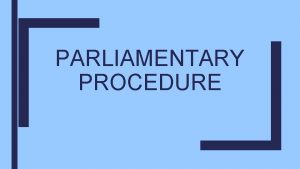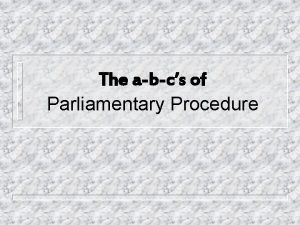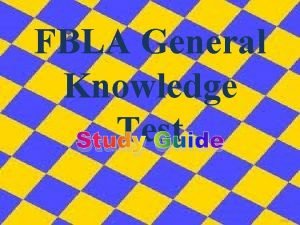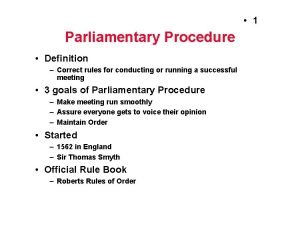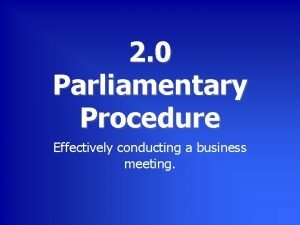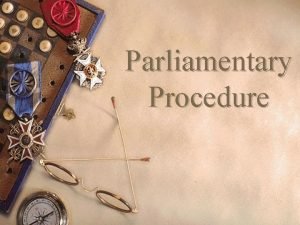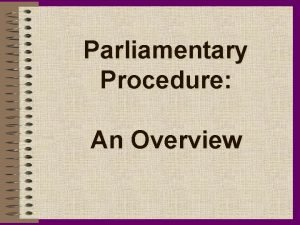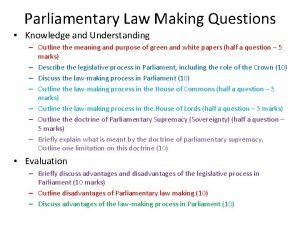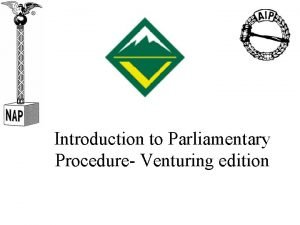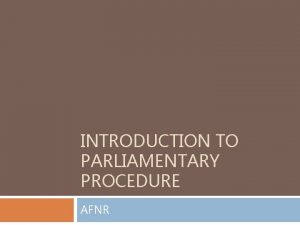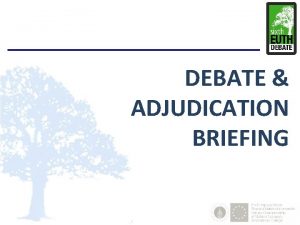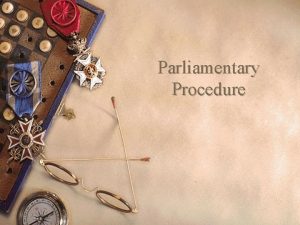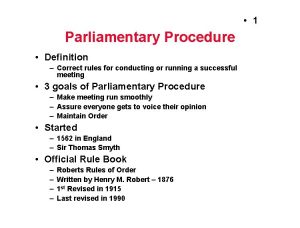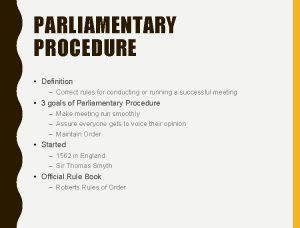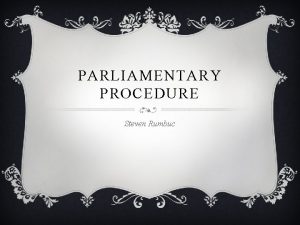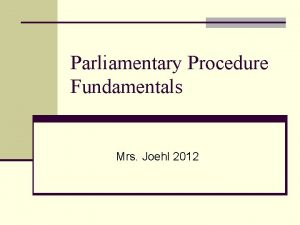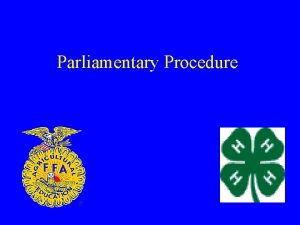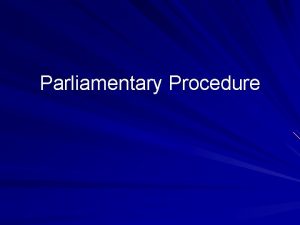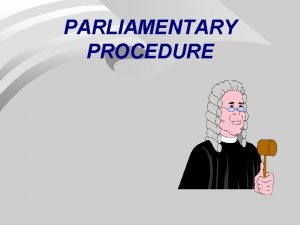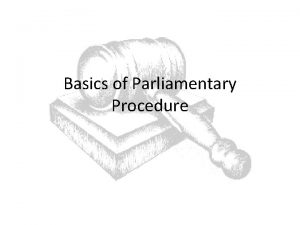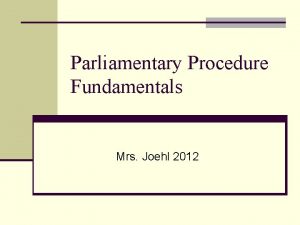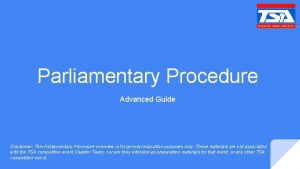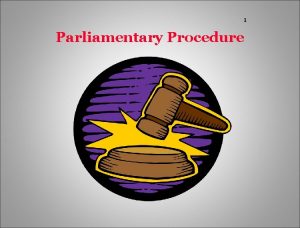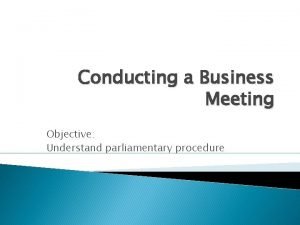PARLIAMENTARY PROCEDURE PARLIAMENTARY PROCEDURE Rules for conducting a


























- Slides: 26

PARLIAMENTARY PROCEDURE

PARLIAMENTARY PROCEDURE Rules for conducting a successful meeting. Goals of Parliamentary Procedure � Extend courtesy to everyone. � Focus on one thing at a time. � Observes the rule of the majority. � Ensures the rights of the minority.

TERMINOLOGY What is a quorum? � ½ of the members plus 1. � Minimum number of members that must be present at a meeting for legal business to be transacted. � Refer to Bylaws. Quorum requirements may be different. What is a majority? � ½ of members present at any meeting plus 1. � Minimum number of members that must vote for a motion for it to pass.

PARLIAMENTARY PROCEDURE BASICS Presiding Officer referred to as: � Mr. /Madam President � Mr. /Madam Chairperson Everyone gets a chance to voice their opinion or debate. Everyone gets the chance to vote � Must be a yes or no vote. � Refer to Bylaws. Associate members may not have this privilege.

PARLIAMENTARY PROCEDURE BASICS There are four methods of voting. � Voice � Standing � Roll Call � Secret Ballot Can the chairman vote? � YES, in order to force a tie or to break one if they are a member of the group.

PARLIAMENTARY PROCEDURE BASICS Only one topic at a time can be discussed. The person who makes a motion has the right to discuss it first.

ORDER OF BUSINESS A meeting should have a set agenda. Purpose of the Order of Business (Agenda) is to keep the meeting moving forward. � Dunbar’s page 1 The agenda forms the framework for the development of a good business meeting � Agenda and Minutes Templates available on the intranet

MAIN MOTIONS Used to introduce new ideas to the assembly.

MAIN MOTIONS Requires a 2 nd, amendable, debatable, majority vote Main Motions that are not legal: �Break any local, state, or national law. �One that brings up a previously failed motion. �Items that are out of the power of the group.

MAIN MOTIONS The person who makes a motion cannot speak against it. Main motions can be reconsidered. Proper � Mr. Example: President, I move that the Farm Bureau hold a cookout for all members.

STEPS TO HANDLING A MAIN MOTION Member asks to be recognized by the President recognizes member by name. Motion is stated. Motion is seconded. Dunbar’ Motion is repeated by President. s page 3 Motion is discussed. President restates motion. Motion is voted upon. Results of vote announced by President.

SUBSIDIARY MOTIONS Assist the assembly in handling or disposing of a main motion.

LAY ON THE TABLE Purpose: � To defer action on the motion until later in the meeting or until the next meeting. Requires a 2 nd, not amendable, not debatable, majority vote PREVIOUS QUESTION Purpose: � To force an immediate vote on the motion. Requires a 2 nd, not amendable, not debatable, 2/3 majority vote

LIMIT OR EXTEND DEBATE Purpose: � To limit or lengthen the time allowed for discussion on a motion when it is clear that there will be an excessive amount of discussion or when the amount of time for the meeting is limited. Requires a 2 nd, amendable*, 2/3 majority � *Amount of time or number of speakers only Maker � The of the motion must specify: amount of time � The number of speakers that can debate the motion. vote

POSTPONE DEFINITELY Purpose: � Allow for the motion on the floor to be deferred to a different day, meeting, or until a certain event. Requires a 2 nd, amendable, debatable, majority vote POSTPONE INDEFINITELY Purpose: � To kill a main motion. Requires a 2 nd, not amendable, debatable, majority vote Can be reconsidered only if passed

REFER TO COMMITTEE Purpose: � Used to send a pending question to a small group so that the question may be carefully investigated. Requires a 2 nd, amendable, debatable, majority vote President must specify when the committee should report back to the board. Committee can be given full power to act. (Refer to Bylaws)

AMEND Purpose: � Use to modify or change a main motion. Requires a 2 nd, amendable, debatable, majority vote, can be reconsidered Must be closely related to the original topic. Can be amended in 4 ways: � Inserting in the middle � Adding to the end � Striking out and inserting

AMEND Proper Example: � Motion Dunbar’ s page 4 on the floor: The Farm Bureau hold a cookout for all members. � Amendment: Mr. President, I move to amend the motion by inserting on March 1 st in front of cookout. So the motion would read, I move that the Farm Bureau hold a cookout on March 1 st for all members.

PRIVILEGED MOTIONS Do not relate to the pending business, but have to do with special matters of immediate and overriding importance.

PRIVILEGED MOTIONS Fixed Time to Which to Adjourn � Requires vote 2 nd, amendable, not debatable, majority Recess � Requires Raise 2 nd, amendable, debatable, majority vote a Question of Privilege � Not amendable, not debatable, no vote – President’s decision Call for the Orders of the Day � Not amendable, not debatable

INCIDENTAL MOTIONS Relate to the pending business.

INCIDENTAL MOTIONS Appeal (Appeal the decision of the Chair) � Requires vote Division � Not of the Assembly amendable, not debatable, no vote needed Division � Not of a Question amendable, not debatable, no vote required Objection � Not 2 nd, not amendable, debatable, majority to the Consideration of a Question amendable, not debatable, 2/3 majority vote Parliamentary � Not Inquiry amendable, not debatable, no vote required

INCIDENTAL MOTIONS Point � Not of Order amendable, not debatable, President decides Suspend the Rules � Requires 2 nd, not amendable, not debatable, 2/3 majority vote Withdraw � Not a Motion amendable, not debatable � If made before President states the motion, it is automatically withdrawn � If made after President states the motion, must ask if any objections. If object, need 2 nd & majority vote

MOTIONS THAT BRING A QUESTION AGAIN BEFORE THE ASSEMBLY

RECONSIDER Purpose: �To reevaluate a decision made earlier. Requires a 2 nd, not amendable, debatable, majority vote If passed, the motion to be reconsidered is handled as if it were never voted on. Can only be made by a person who voted on the prevailing side and during the meeting at which the vote on the original motion was taken.

RESCIND Purpose: � To repeal a previous action. Requires a 2 nd, amendable, debatable, 2/3 majority vote without prior warning TAKE FROM THE TABLE Purpose: � To take a motion that is on the table off of the table. Requires as 2 nd, not amendable, not debatable, majority vote
 All in favor say aye gif
All in favor say aye gif Hosa parliamentarian
Hosa parliamentarian Parliamentary procedure model un
Parliamentary procedure model un Abc's of parliamentary procedure
Abc's of parliamentary procedure Fbla knowledge quiz answers
Fbla knowledge quiz answers Parliamentary procedure definition
Parliamentary procedure definition Parliamentary procedure at a glance
Parliamentary procedure at a glance Parliamentary procedure hosa
Parliamentary procedure hosa Parliamentary procedure vocabulary
Parliamentary procedure vocabulary Parliamentary procedure definition
Parliamentary procedure definition History of parliamentary procedure
History of parliamentary procedure Parliamentary procedure outline
Parliamentary procedure outline Introduction to parliamentary procedure
Introduction to parliamentary procedure Introduction to parliamentary procedure
Introduction to parliamentary procedure Asian debate format
Asian debate format Kontinuitetshantering i praktiken
Kontinuitetshantering i praktiken Novell typiska drag
Novell typiska drag Nationell inriktning för artificiell intelligens
Nationell inriktning för artificiell intelligens Ekologiskt fotavtryck
Ekologiskt fotavtryck Shingelfrisyren
Shingelfrisyren En lathund för arbete med kontinuitetshantering
En lathund för arbete med kontinuitetshantering Underlag för särskild löneskatt på pensionskostnader
Underlag för särskild löneskatt på pensionskostnader Vilotidsbok
Vilotidsbok A gastrica
A gastrica Densitet vatten
Densitet vatten Datorkunskap för nybörjare
Datorkunskap för nybörjare Boverket ka
Boverket ka

